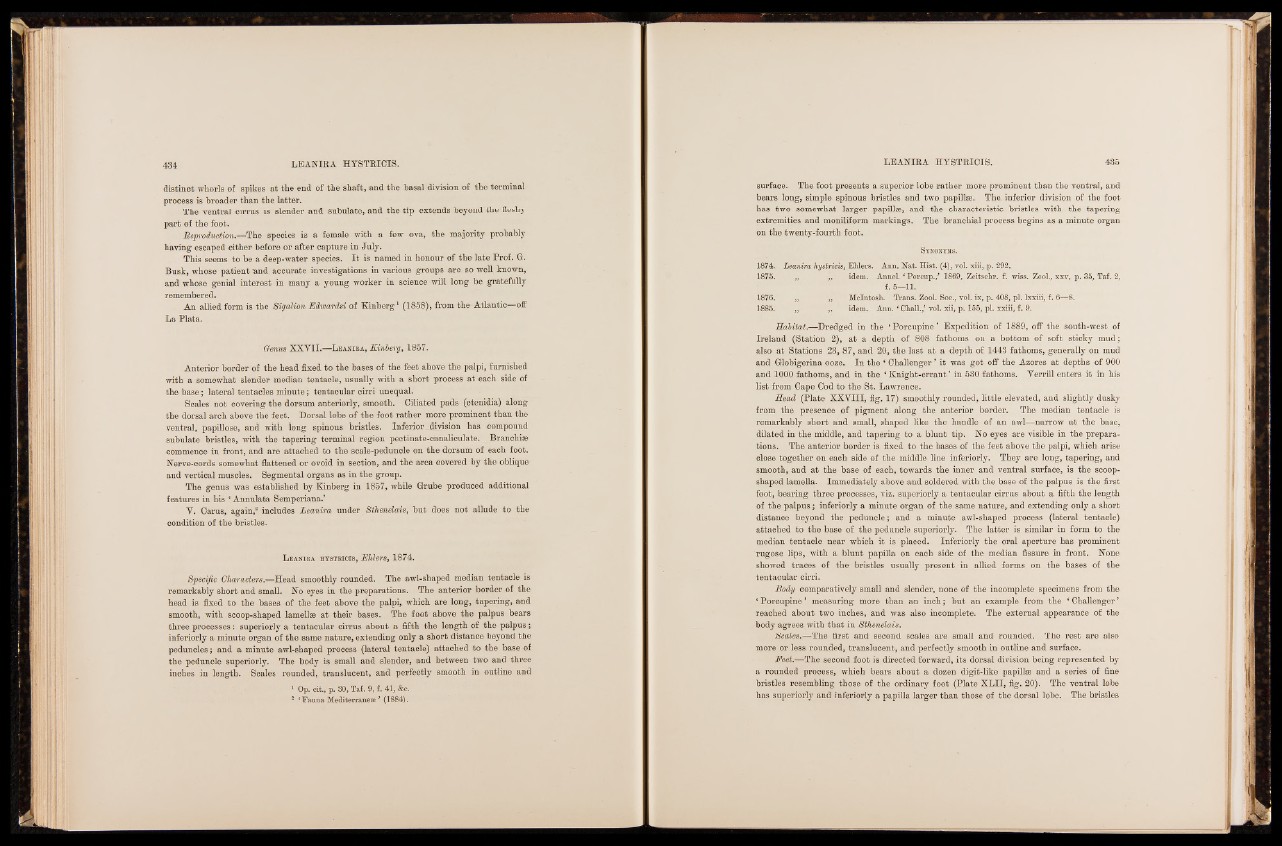
distinct whorls of spikes at the end of the shaft, and the basal division of the terminal
process is broader than the latter.
The ventral cirrus is slender and subulate, and the tip extends beyond the fleshy
part of the foot.
Rep'oduction.—The species is a female with a few ova, the majority probably
having escaped either before or after capture in July.
This seems to be a deep-water species. I t is named in honour of the late Prof. G.
Busk, whose patient'and. accurate investigations in various groups are so well known,
and whose genial interest in many a young worker in science will long be gratefully
remembered.
An allied form is the Sigalion Edwardsi of Kinberg1 (1858), from the Atlantic—off
La Plata.
Genus XXVII.—L eanira, Kinberg, 1857.
Anterior border of the head fixed to the bases of the feet above the palpi, furnished
with a somewhat slender median tentacle, usually with a short process at each side of
the base; lateral tentacles minute; tentacular cirri unequal.
Scales not covering the dorsum anteriorly, smooth. Ciliated pads (ctenidia) along
the dorsal arch above the feet. Dorsal lobe of the foot rather more prominent than the
ventral, papillose, and with long spinous bristles. Inferior division has compound
subulate bristles, with the tapering terminal region pectinate-canaliculate. Branchia?
commence in front, and are attached to the scale-peduncle on the dorsum of each foot.
Nerve-cords somewhat flattened or ovoid in section, and the area covered by the oblique
and vertical muscles. Segmental organs as in the group.
The genus was established by Kinberg in 1857, while Grube produced additional
features in his * Annulata Semperiana.’
V. Carus, again,2 includes Leanira under Sthenelais, but does not allude to the
condition of the bristles.
L eanira hystriois, Ehlers, 1874.
Specific Characters.—Head smoothly rounded. The awl-shaped median tentacle is
remarkably short and small. No eyes in the preparations. The anterior border of the
head is fixed to the bases of the feet above the palpi, which are long, tapering, and
smooth, with scoop-shaped lamellae at their bases. The foot above the palpus bears
three processes: superiorly a tentacular cirrus about a fifth the length of the palpus;
inferiorly a minute organ of the same nature, extending only a short distance beyond the
peduncles; and a minute awl-shaped process (lateral tentacle) attached to the base of
the peduncle superiorly. The body is small and slender, and between two and three
inches in length. Scales rounded, translucent, and perfectly smooth in outline and
1 Op. cit., p. 30, Taf. 9, f. 41, &c.
3 f Fauna Mediterranean ’ (1884).
surface. The foot presents a superior lobe rather more prominent than the ventral, and
bears long, simple spinous bristles and two papilla. The; inferior division of the foot
has two somewhat larger papilla?, and the characteristic bristles with the tapering
extremities and moniliform markings. The branchial process begins as a minute organ
on the twenty-fourth foot.
S yno nyms.
1874. Leanira hystricis, Ehlers. Ann. Nat. Hist. (4), vol. xiii, p. 292.
1875. „ . idem. Annel. ‘ Porcup./ 1869, Zeitschr.-f. wiss. Zool., xxv, p. 35, Taf. 2,
f. 5—11.
1876. „ „ McIntosh. Trans. Zool. Soc., vol. ix, p. 408, pi. lxxiii, f. 6—8.
1885. „ ,, idem. Ann. ‘ Chall.,’ vol. xii, p. 155, pi. xxiii, f. 9.
Habitat.—Dredged in the ‘ Porcupine ’ Expedition of 1889, off the south-west of
Ireland (Station 2), at a depth of 808 fathoms on a bottom of soft sticky mud;
also at Stations 23, 87, and 20, the last at a depth of 1443 fathoms, generally on mud
and Globigerina ooze. In the ‘ Challenger 5 it was got off the Azores at depths of 900
and 1000 fathoms, and in the ‘Knight-errant* in 530 fathoms. Verrill enters it in his
list from Cape Cod to the St. Lawrence.
Head (Plate XXVIII, fig. 17) smoothly rounded, little elevated, and slightly dusky
from the presence pf pigment along the anterior border. The median tentacle is
remarkably short and small, shaped like the handle of an awl—narrow at the base,
dilated in the middle, and tapering to a blunt tip. No eyes are visible in the preparations.
The anterior border is fixed to the bases of the feet above the palpi, which arise
close together on each side of the middle line inferiorly. They are long, tapering, and
smooth, and at the base of each, towards the inner and ventral surface, is the scoopshaped
lamella. Immediately above and soldered with the base of the palpus is the first
foot, bearing three processes, viz. superiorly a tentacular cirrus about a fifth the length
of the palpus; inferiorly a minute organ of the same nature, and extending only a short
distance beyond the peduncle; and a minute awl-shaped process (lateral tentacle)
attached to the base of the peduncle superiorly. The latter is similar in form to the
median tentacle near which it is placed. Inferiorly the oral aperture has prominent
rugose lips, with a blunt papilla on each side of the median fissure in front. None
showed traces of the bristles usually present in allied forms on the bases of the
tentacular cirri.
Body comparatively small and slender, none of the incomplete specimens from the
‘ Porcupine ’ measuring more than an inch; but an example from the ‘ Challenger ’
reached about two inches, and was also incomplete. The external appearance of the
body agrees with that in Sthenelais.
Scales.—The first and second scales are small and rounded. The rest are also
more or less rounded, translucent, and perfectly smooth in outline and surface.
Feet.—The second foot is directed forward, its dorsal division being represented by
a rounded process, which bears about a dozen digit-like papilla? and a series of fine
bristles resembling those of the ordinary foot (Plate XLII, fig. 20). The ventral lobe
has superiorly and inferiorly a papilla larger than those of the dorsal lobe. The bristles